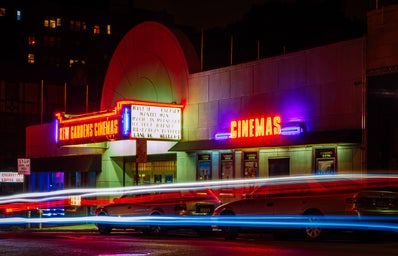A harrowing tale with a plot as up and down as the steep San Francisco hills, The Last Black Man in San Francisco (2019) is a tribute to the coastal city as well as adult friendship, adult adventures, and family ties. This slice of life film is inspired by the real-life story of Jimmie Fails, who plays himself, rendering this film a work of nonfiction despite it feeling like a fable.
Jimmie’s (real life) childhood friend, Joe Talbot, directed and produced this A24 film which is a manifestation of the pair’s young San Franciscan dream to make a movie based on their lived experiences. This passion project is Joe Talbot’s feature directorial debut, so it’s safe to say that we’ll see more of this talented Talbot in the future.
(Director) Joe Talbot, and (actor) Jimmie Fails both call San Francisco home, naturally adding a thick layer of authenticity to the film. Their familiar relationship with the city generates a thematic organic color palette as serene as a Monet and as surreal as a Vincent van Gogh. The Last Black Man in San Francisco (2019) follows two young black men, Jimmie (Jimmie Fails), a skater who picks up shifts at a nursing home, and Montgomery (Jonathan Majors), a thoughtful playwright with a job as a fishmonger.
Jimmie is raised by his father (Rob Morgan) in a stately Victorian-style house which, according to family legend, was built by Jimmie’s grandfather. Eventually, gentrification took the Victorian out of the Fails’ hands with a spiked property value in the millions due its prime location. As a result, Jimmie and his father found themselves displaced in housing projects, shelters, their car, and for Jimmie, a group home.
Now grown, Jimmie desires to reclaim the Victorian house where his family once lived, in the now-gentrified Fillmore District. Similar to the feeling of wanting something you can’t have, therefore wanting it even more, Jimmie fixates on reclaiming his childhood home, but it is out of reach due to its value of four million and current occupancy.
In Bayview-Hunters Point, Jimmie lives with his closest friend Montgomery (Jonathan Majors) and Mont’s grandfather (Danny Glover). Jimmie and Montgomery do not fail to bring light to this effortlessly poetic story with their pure but peculiar friendship. Their on-screen kinship is deeply genuine with a healthy dose of codependency and an overdose of trust.
With the Pacific Ocean as the backdrop, the opening sequence is of a young black girl in a red dress, standing on the sidewalk, tilting her head upwards to peer at a white man in a full-body hazmat suit. The girl’s mother calls for her, prompting the child to skip merrily back home. As the camera pans with the young girl, it’s revealed that there are people in hazmat suits, collecting waste with a picker. This begs the question, why do those people have protective suits on? Why doesn’t the young black girl wear a hazmat suit? Why is it even necessary to wear a hazmat suit?
The reality is that The Last Black Man in San Francisco takes place in the coastal neighborhood, Bayview-Hunters Point, which is home to poverty, gang violence, and toxic air, land, and water. Historically, from 1941 to 1974, Bayview-Hunters Point was the location of a Navy shipyard that decommissioned radioactive war ships which, initially, provided jobs in the predominantly black community, but when the shipyard officially closed, unemployment rates soared and the coastal neighborhood had been exposed to atomic chemicals and radiation for decades upon decades. The cleanup effort continues to persist today, in real time.
The overarching theme of The Last Black Man in San Francisco is the marginalization of predominantly black communities. You can’t miss the theme, even among the serene San Franciscan landscapes, cityscapes, and soulful soundtrack, there is a call to action weaved into this story. Depictions of the marginalization of predominantly black communities include the demolition of affordable housing in low income neighborhoods which is juxtaposed by a gaggle of white people in that same neighborhood gliding on an architecture segway tour. Assumedly not an immediate call to action, but (director) Joe Talbot means to pick up the seemingly stagnant conversation about capitalism, gentrification, and neglected black communities, specifically Bayview-Hunters Point.
Jimmie’s obsession with the Victorian house digs deeper than his desire to reclaim his family’s home. Perhaps in the grander scheme, it stems from a place of wanting to belong, finally, albeit in a gentrified neighborhood, but to stake claim to land as a black man in a colonized country.


